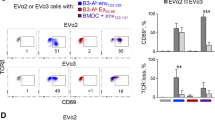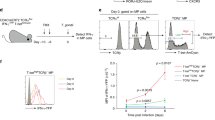Abstract
In defense of the host, the immune system must often raise an effective cytotoxic T lymphocyte (CTL) response from a small number of clonal precursors. The degree to which activation stimuli regulate the expansion and differentiation of naïve CTLs, however, remains unknown. Using an engineered antigen-presenting cell (APC) system that allows control over antigenic stimulation, we studied the signaling duration requirements for priming and clonal expansion of naïve CTLs. We found that naïve CTLs become committed after as little as 2 h of exposure to APCs and that their subsequent division and differentiation can occur without the need for further antigenic stimulation of the daughter cells, whether priming is in vitro or in vivo. These data show that after a brief interaction with stimulatory APCs, naïve CTLs initiate a program for their autonomous clonal expansion and development into functional effectors.
This is a preview of subscription content, access via your institution
Access options
Subscribe to this journal
Receive 12 print issues and online access
$209.00 per year
only $17.42 per issue
Buy this article
- Purchase on Springer Link
- Instant access to full article PDF
Prices may be subject to local taxes which are calculated during checkout







Similar content being viewed by others
References
Harty, J. T., Tvinnereim, A. R. & White, D. W. CD8+ T cell effector mechanisms in resistance to infection. Annu. Rev. Immunol. 18, 275–308 (2000).
Bevan, M. J. Antigen presentation to cytotoxic T lymphocytes in vivo. J. Exp. Med. 182, 639–641 (1995).
Lanzavecchia, A. From antigen presentation to T-cell activation. Res. Immunol. 149, 626 (1998).
Banchereau, J. et al. Immunobiology of dendritic cells. Annu. Rev. Immunol 18, 767–811 (2000).
Heath, W. R., Kurts, C., Miller, J. & Carbone, F. R. Cross-tolerance: A pathway for inducing tolerance to peripheral tissue antigens. J. Exp. Med. 187, 1549–1553 (1998).
Garza, K. M. et al. Role of Antigen-presenting Cells in Mediating Tolerance and Autoimmunity. J. Exp. Med. 191, 2021–2028 (2000).
Sotomayor, E. M. et al. Conversion of tumor-specific CD4+ T-cell tolerance to T-cell priming through in vivo ligation of CD40. Nature Med. 5, 780–787 (1999).
Keene, J. & Forman, J. Helper activity is required for the in vivo generation of cytotoxic T lymphocytes. J. Exp. Med. 155, 768–782 (1982).
Bennett, S. R. M., Carbone, F. R., Karamalis, F., Miller, J. F. A. P. & Heath, W. R. Induction of a CD8+ cytotoxic T lymphocyte response by cross-priming requires cognate CD4+ T cell help. J. Exp. Med. 186, 65–70 (1997).
Schoenberger, S. P. et al. T-cell help for cytotoxic T lymphocytes is mediated by CD40-CD40L interactions. Nature 393, 480–483 (1998).
Bennett, S. R. et al. Help for cytotoxic-T-cell responses is mediated by CD40 signaling. Nature 393 478–480 (1998).
Ridge, J. P., Di Rosa, F. & Matzinger, P. A conditioned dendritic cell can be a temporal bridge between a CD4+ T-helper and a T-killer cell. Nature 393, 474–478 (1998).
Gallucci, S., Lolkema, M. & Matzinger, P. Natural adjuvants: endogenous activators of dendritic cells. Nature Med. 5, 1249–1255 (1999).
Cella, M. et al. Maturation, activation, and protection of dendritic cells induced by double-stranded RNA. J. Exp. Med. 189, 821–829 (1999).
Sauter, B. et al. Consequences of cell death: exposure to necrotic tumor cells, but not primary tissue cells or apoptotic cells, induces the maturation of immunostimulatory dendritic cells. J. Exp. Med. 191, 423–434 (2000).
Binder, R. J., Anderson, K. M., Basu, S. & Srivastava, P. K. Cutting edge: heat shock protein gp96 induces maturation and migration of CD11c+ cells in vivo. J. Immunol. 165, 6029–6035 (2000).
Basu, S., Binder, R. J., Suto, R., Anderson, K. M. & Srivastava, P. K. Necrotic but not apoptotic cell death releases heat shock proteins, which deliver a partial maturation signal to dendritic cells and activate the NF-κB pathway. Int. Immunol. 12, 1539–1546 (2000).
Lafferty, K. J. & Cunningham, A. J. A new analysis of allogeneic interactions. Aust. J. Exp. Biol. Med. Sci. 53, 27–42 (1975).
Slavik, J. M., Hutchcroft, J. E. & Bierer, B. E. CD28/CTLA-4 and CD80/CD86 families: signaling and function. Immunol. Res. 19, 1–24 (1999).
Lanzavecchia, A. & Sallusto, F. From synapses to immunological memory: the role of sustained T cell stimulation. Curr. Opin. Immunol. 12, 92–98 (2000).
Viola, A., Schroeder, S., Sakakibara, Y. & Lanzavecchia, A. T lymphocyte costimulation mediated by reorganization of membrane microdomains. Science 283, 680–682 (1999).
Borriello, F. et al. B7–1 and B7-2 have overlapping, critical roles in immunoglobulin class switching and germinal center formation. Immunity 6, 303–313 (1997).
McAdam, A. J., Farkash, E. A., Gewurz, B. E. & Sharpe, A. H. B7 costimulation is critical for antibody class switching and CD8+ cytotoxic T-lymphocyte generation in the host response to vesicular stomatitis virus. J. Virol. 74, 203–208 (2000).
McAdam, A. J., Gewurz, B. E., Farkash, E. A. & Sharpe, A. H. Either B7 costimulation or IL-2 can elicit generation of primary alloreactive CTL. J. Immunol. 165, 3088–3093 (2000).
Santra, S. et al. Functional Equivalency of B7–1 and B7-2 for Costimulating Plasmid DNA Vaccine-Elicited CTL Responses. J. Immunol. 165, 6791–6795 (2000).
Lanzavecchia, A. Dendritic cell maturation and generation of immune responses. Haematologica 84, 23–25 (1999).
Schoenberger, S. P. et al. Efficient direct priming of tumor-specific cytotoxic T lymphocyte in vivo by an engineered APC. Cancer. Res. 58, 3094–3100 (1998).
Sanderson, S. & Shastri, N. LacZ inducible, antigen/MHC-specific T cell hybrids. Int. Immunol. 6, 369–376 (1994).
Hogquist, K. A. et al. T cell receptor antagonist peptides induce positive selection. Cell 76, 17–27 (1994).
Lyons, A. B. Divided we stand: tracking cell proliferation with carboxyfluorescein diacetate succinimidyl ester. Immunol. Cell Biol. 77, 509–515 (1999).
Huang, J. F. et al. TCR-Mediated internalization of peptide-MHC complexes acquired by T cells. Science 286, 952–954 (1999).
Hwang, I. et al. T cells can use either T cell receptor or CD28 receptors to absorb and internalize cell surface molecules derived from antigen-presenting cells. J. Exp. Med. 191, 1137–1148 (2000).
Nikolic-Zugic, J. & Bevan, M. J. Role of self-peptides in positively selecting the T-cell repertoire. Nature 344, 65–67 (1990).
Bronstein-Sitton, N., Wang, L., Cohen, L. & Baniyash, M. Expression of the T cell antigen receptor ζ chain following activation is controlled at distinct checkpoints. Implications for cell surface receptor down-modulation and re-expression. J. Biol. Chem. 274, 23659–23665 (1999).
San Jose, E., Borroto, A., Niedergang, F., Alcover, A. & Alarcon, B. Triggering the TCR complex causes the downregulation of nonengaged receptors by a signal transduction-dependent mechanism. Immunity 12, 161–170 (2000).
Viola, A. & Lanzavecchia, A. T cell activation determined by T cell receptor number and tunable thresholds. Science 273, 104–106 (1996).
Swain, S. L. Lymphokines and the immune response: the central role of interleukin-2. Curr. Opin. Immunol. 3, 304–310 (1991).
Jelley-Gibbs, D. M., Lepak, N. M., Yen, M. & Swain, S. L. Two distinct stages in the transition from naive CD4 T cells to effectors, early antigen-dependent and late cytokine-driven expansion and differentiation. J. Immunol. 165, 5017–5026 (2000).
Iezzi, G., Karjalainen, K. & Lanzavecchia, A. The duration of antigenic stimulation determines the fate of naive and effector T cells. Immunity 8, 89–95 (1998).
Karttunen, J. & Shastri, N. Measurement of ligand-induced activation in single viable T cells using the lacZ reporter gene. Proc. Natl Acad. Sci. USA 88. 3972–3976 (1991).
Veiga-Fernandes, H., U., W., Bourgeois, C., McLean, A. & Rocha, B. Response of naive and memory CD8+ T cells to antigen stimulation in vivo. Nature Immunol. 1, 47–53 (2000).
Staudt, L. M. & Brown, P. O. Genomic views of the immune system. Annu. Rev. Immunol. 18, 829–859 (2000).
Murali-Krishna, K. et al. In vivo dynamics of anti-viral CD8 T cell responses to different epitopes. An evaluation of bystander activation in primary and secondary responses to viral infection. Adv. Exp. Med. Biol. 452, 123–142 (1998).
Murali-Krishna, K. et al. Counting antigen-specific CD8 T cells: a reevaluation of bystander activation during viral infection. Immunity 8, 177–187 (1998).
Kurts, C., Kosaka, H., Carbone, F. R., Miller, J. F. A. P. & Heath, W. R. Class I-restricted cross-presentation of exogenous self-antigens leads to deletion of autoreactive CD8+ T cells. J. Exp. Med. 186, 239–245 (1997).
Zhang, J., MacLennan, I. C., Liu, Y. J. & Lane, P. J. Is rapid proliferation in B centroblasts linked to somatic mutation in memory B cell clones? Immunol. Lett. 18, 297–299 (1988).
Matzinger, P. The JAM test. A simple assay for DNA fragmentation and cell death. J. Immunol. Meth. 145, 185–192 (1991).
Acknowledgements
We thank G. Palioungas, P. Houshmand, K. Banks and the staff of the LIAI animal facility for excellent care and screening of mice. We also thank F. Koning and E. Sercarz for critical evaluation of the manuscript. Supported by the American Cancer Society (to S. P. S.) and the Dutch Cancer Society (to M. J. B. v. S).
Author information
Authors and Affiliations
Corresponding author
Rights and permissions
About this article
Cite this article
van Stipdonk, M., Lemmens, E. & Schoenberger, S. Naïve CTLs require a single brief period of antigenic stimulation for clonal expansion and differentiation. Nat Immunol 2, 423–429 (2001). https://doi.org/10.1038/87730
Received:
Accepted:
Issue Date:
DOI: https://doi.org/10.1038/87730
This article is cited by
-
Hallmarks of CD8+ T cell dysfunction are established within hours of tumor antigen encounter before cell division
Nature Immunology (2023)
-
Trogocytic molting of T cell microvilli upregulates T cell receptor surface expression and promotes clonal expansion
Nature Communications (2023)
-
Activated-memory T cells influence naïve T cell fate: a noncytotoxic function of human CD8 T cells
Communications Biology (2022)
-
The timing of differentiation and potency of CD8 effector function is set by RNA binding proteins
Nature Communications (2022)
-
Clonal expansion of innate and adaptive lymphocytes
Nature Reviews Immunology (2020)



